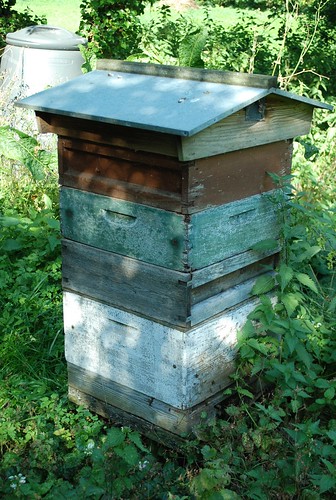 It is early autumn, so an old man's thoughts turn to his bees. Sadly neglected again, I wonder what they are up to? Have they produced a good honey harvest or - more likely given the rather unfortunate summer here - have they just survived? Happily I have some Apistan all saved up, and its, harumph, only a few months past its best-before date, so that'll be fine.
It is early autumn, so an old man's thoughts turn to his bees. Sadly neglected again, I wonder what they are up to? Have they produced a good honey harvest or - more likely given the rather unfortunate summer here - have they just survived? Happily I have some Apistan all saved up, and its, harumph, only a few months past its best-before date, so that'll be fine.
This is going to be a long tedious post, since it occurs to me I've never done a proper one showing all the steps, and it might be fun. Its also a diary entry for my future reference. The first pix shows the hive as I found it - perhaps a touch overgrown. It doesn't bother the bees, but I find it convenient to grub out some of the nettles.
Here's the kit. Jacket with built-in veil, nice cotton ventile trousers (actually those are windies, ex-BAS stock from the Sally Army), wellies, secateurs (not needed) and the always-useful hive tool , also convenient for weeding. The leather gauntlets are also convenient for pulling up nettles with.
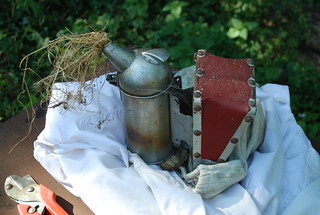 I forgot my friend Mr Smoker. You feed him with cardboard, and he gives out smoke, which makes the bees more passive. I'm told its because it makes the bees think of forest fires, which makes them forget about attacking you can go off and fill up with honey in case they need to Abandon Hive. Well, who knows, they are very small and have only tiny brains.
I forgot my friend Mr Smoker. You feed him with cardboard, and he gives out smoke, which makes the bees more passive. I'm told its because it makes the bees think of forest fires, which makes them forget about attacking you can go off and fill up with honey in case they need to Abandon Hive. Well, who knows, they are very small and have only tiny brains.
He's stuffed up with dried grass because if you put in fresh grass last time then the cardboard stops burning and you can use it again next time because you forgot to bring any fresh out with you.
 That's much better, isn't it. Weeds all gone. Ahem.
That's much better, isn't it. Weeds all gone. Ahem.
Notice that the alighting board has rotted away. I got this hive stand from a friend about 10 years ago who was giving up keeping, and I fear that come next spring or summer I really am going to have to find the time to renew it.
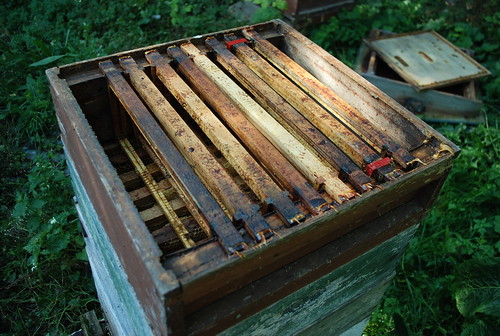 Take the roof off, and the crown board, and here's the top super. Um. Not much there. Not even blank sheets of wax, because when I did this - in spring - I didn't have any spare wax, so I just gave them empty frames, vaguely hoping that the might fill it in nicely. But alas they haven't been busy enough for that - looks like it won't be a bumper harvest.
Take the roof off, and the crown board, and here's the top super. Um. Not much there. Not even blank sheets of wax, because when I did this - in spring - I didn't have any spare wax, so I just gave them empty frames, vaguely hoping that the might fill it in nicely. But alas they haven't been busy enough for that - looks like it won't be a bumper harvest.
Note that the bars aren't black with fire, its just that the wax gets that colour with time as it ages and the bees teensy tiny little feet walk over it.
Lets move on down.
 At last, there is something there. But not much. Lets pull out a frame and see what we can see.
At last, there is something there. But not much. Lets pull out a frame and see what we can see.
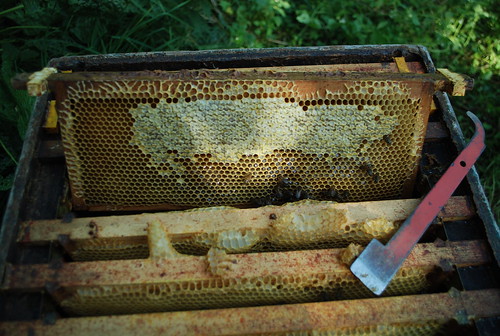 Well, there's honey there, you can see it glinting. Quite dark-looking too. Only some of it is capped though - that patch at the top you can see. The bees cap the honey when its ready - when they've evaporated it enough that it won't ferment, which means that they can store it over winter or I can steal it.
Well, there's honey there, you can see it glinting. Quite dark-looking too. Only some of it is capped though - that patch at the top you can see. The bees cap the honey when its ready - when they've evaporated it enough that it won't ferment, which means that they can store it over winter or I can steal it.
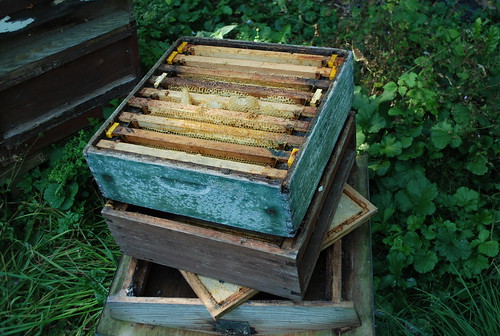 As I work down, I put the supers in reverse order on top of the upturned lid. This would work a bit better if the roof were flat, like in most hives.
As I work down, I put the supers in reverse order on top of the upturned lid. This would work a bit better if the roof were flat, like in most hives.
Notice the coloured spacers at the end of the frames. These are convenient though purists complain that they prevent you adjusting them close.
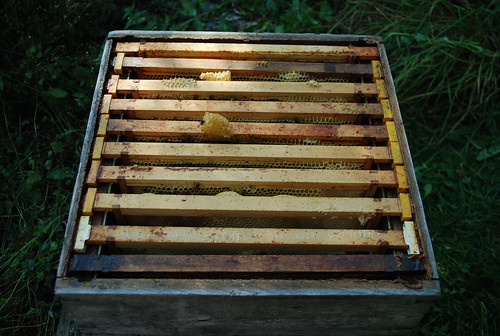 Now we're at the bottom super. Again, some combs with a reasonable amount of honey in them, but not much sealed. By now its clear that it isn't really worth me taking the honey off. I'll just leave them with it, they'll live on it over winter, and any spare can be harvested in the spring. Oh well.
Now we're at the bottom super. Again, some combs with a reasonable amount of honey in them, but not much sealed. By now its clear that it isn't really worth me taking the honey off. I'll just leave them with it, they'll live on it over winter, and any spare can be harvested in the spring. Oh well.
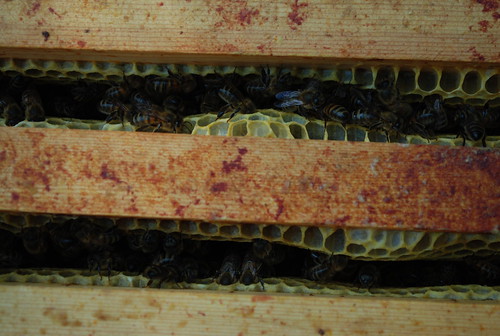 Looking down from above. The space between the comb is packed with bees.
Looking down from above. The space between the comb is packed with bees.
They like to stay safe in the darkness.
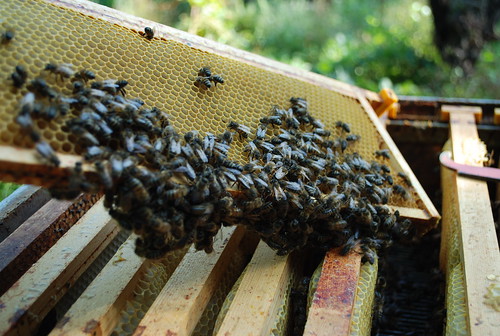 Lifting out a frame to look, the bees cling on. They act like a semi-fluid mass, and drip off in globs. Today they are all in a pretty good mood - no anger, no attempt to sting at all. Its quite warm, quite still, and I haven't done anything in particular to wind them up, so maybe this is my reward.
Lifting out a frame to look, the bees cling on. They act like a semi-fluid mass, and drip off in globs. Today they are all in a pretty good mood - no anger, no attempt to sting at all. Its quite warm, quite still, and I haven't done anything in particular to wind them up, so maybe this is my reward.
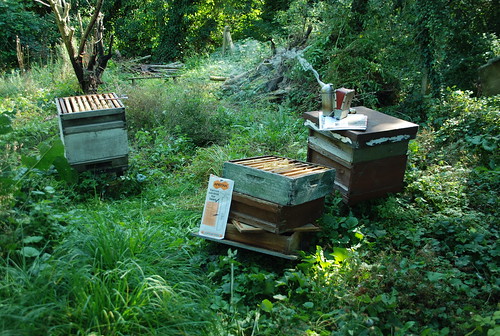 The bucolic scene. Mr Smoker perfumes the air. Ah, but he has been joined by a friend. Who is that? Its Mr Apistan, foe of mites.
The bucolic scene. Mr Smoker perfumes the air. Ah, but he has been joined by a friend. Who is that? Its Mr Apistan, foe of mites.
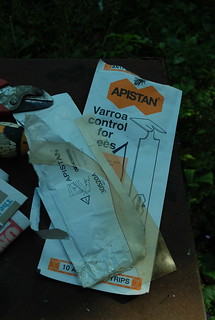 In more detail. Apistan comes in strips: you hang a pair in the brood box down in between the combs. The bees walk over it, pick up the stuff, and transmit it through the hive and ideally it kills all the naughty varroa mites.
In more detail. Apistan comes in strips: you hang a pair in the brood box down in between the combs. The bees walk over it, pick up the stuff, and transmit it through the hive and ideally it kills all the naughty varroa mites.
If you don't do this about once a year (using Apistan, or whatever this year's flavour of anti-varroa stuff is) then the mites overwhelm the bees and the hive dies. Apparently its a tropical bee parasite, and tropical bees are smaller, and able to groom off the mites, so they don't get wiped out. Another problem of globalisation.
This means that there are, essentially, no wild honey bee hives in the UK. Or, I presume, Europe.
 With the last super off, we come to the queen excluder - just a board outline holding wires, carefully spaced so the bees can get through but the queen, who is significantly larger, can't. So she is confined to the brood box and can only lay larvae in there. If she started laying in the supers, you'd get baby bee juice in your honey, and you wouldn't like that.
With the last super off, we come to the queen excluder - just a board outline holding wires, carefully spaced so the bees can get through but the queen, who is significantly larger, can't. So she is confined to the brood box and can only lay larvae in there. If she started laying in the supers, you'd get baby bee juice in your honey, and you wouldn't like that.
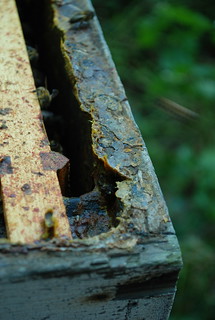 Another of the many fascinating things about bees is the way they stick their hive together. Here (and here and here and here) we see the propolis and wax that so effectively gums up the hive, glueing one super to another and the frames into the supers.
Another of the many fascinating things about bees is the way they stick their hive together. Here (and here and here and here) we see the propolis and wax that so effectively gums up the hive, glueing one super to another and the frames into the supers.
 Oh look! A bright orange spot. In a well-regulated hive, this might be a sign of the queen - what you're supposed to do, once you've caught the queen, is to mark her with a dot of paint so you can easily find her again. I've always found that its the first "once you've caught the queen" that's the killer, and I don't bother. Wise bee keepers never venture down into the depths and mysteries of the Brood Box. Though it looks as though I really ought to renew some of the frames in there.
Oh look! A bright orange spot. In a well-regulated hive, this might be a sign of the queen - what you're supposed to do, once you've caught the queen, is to mark her with a dot of paint so you can easily find her again. I've always found that its the first "once you've caught the queen" that's the killer, and I don't bother. Wise bee keepers never venture down into the depths and mysteries of the Brood Box. Though it looks as though I really ought to renew some of the frames in there.
So, oh yes, the orange spot: its pollen (perhaps a Truely Excellent botanist would be able to deduce the plant :-) which the bees need for protein, I think. A good sign.
 And lastly... its impossible to keep bees without killing some. But never mind: the thing that is really alive is the hive; individual bees are like hair or fingernails, and are disposable.
And lastly... its impossible to keep bees without killing some. But never mind: the thing that is really alive is the hive; individual bees are like hair or fingernails, and are disposable.
Refs
* The Beetard
* "Spring" bees, actually June
* Autumn 2011

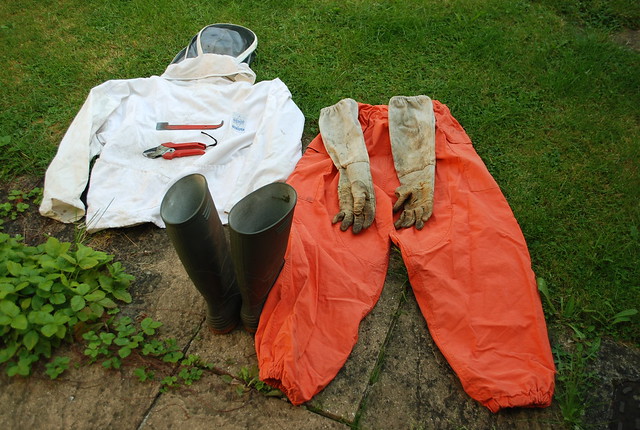

Thank you.
Cool stuff.
sherlock holmes was a beekeeper in the end, too, wasn't he?
What! *splutter*
"The thing that is really alive is the hive; individual bees are like hair or fingernails, and are disposable."
I hope you're not talking about a superorganism... Dangerous ground. You'll be banging on about group selection and other evolutionary heresies before long. Be careful, Richard Dawkins will send round that Pharyngula guy to beat you up with talk like that. They'll torture you to confess: kin selection explains everything. End of.
having seen Honey in these parts range from water white to pale amber year by year, I'd appreciate a short discourse on the stages by which mead ages , and wheter vintages matter
Thanks for posting this. I used to help some beekeeping friends with their honey harvest every year. These pictures and your comments are inducing nostalgia.
So no harvest because of 1) poor summer weather for the bees 2) lax spring maintenance & 3) you need to leave them enough to survive the winter?
[Yes to 1. 2 is dubious, and probably wrong: I have a long-term need to replace some of the frames, but I doubt that affected them. 3 maybe: its possible to feed the bees with sugar solution, which allows you to nick all their honey. But then you have to buy sugar (or made-up solution) and go through the tedium of feeding it, so I never bother -W]
Thanks. I thought "I didn’t have any spare wax, so I just gave them empty frames, " meant they would have produced more if they were given some extra wax.
[Maybe that deserves more explanation. As it turns out, they didn't attempt to do anything with those empty frames at all - so it didn't matter. If they had tried to do something, they would have needed to first fill them with wax foundation, before putting the honey in. that uses up their resources (they have to secrete the wax) so it would have slowed them down, in that case.
Some bee keepers deliberately produce wax, in preference for honey, cos it can be sold too; they deliberately force the bees to make new cells -W]
What is the energetic cost of wax vs. honey? And damn those varroa mites. We have seen a collapse and perhaps extinction of some bumblebee (Bombus sp.) species. Are they holding their own as far as you can tell? And we also fight the import of Bombus colonies for use in greenhouses, with accompanying diseases.
[I'm not sure of the relative costs; you'd need a scientific beekeeper for that -W]
And Matt, don't ignore haplodiploidy in the evolution of the Hymenoptera--just ask E. O. Wilson.
"no wild honey bee hives in the UK. Or, I presume, Europe"
I thought the honeybee is a Eurasian native. No wild honey bee hives anywhere in their native range?
[Probably a few but I think wild colonies continually die out and are replaced by cultivated bees swarming -W]
Meanwhile the wild hive in the tree down the street from me is going on year five or so. Maybe it's native bees? Guess I should become more educated.
[Take some pictures, see if the wub can identify them -W]
@ Russell
The color of honey, as well as the flavor and tendency to crystallize, is from the source of the nectar. Tulip poplar creates a dark honey, sourwood results in a very light honey. Here in NC there is a phenomenon that occasionally creates blue honey, and reports that it would make people sick. My wife was working with Dr Ambrose(his real name) at NCSU apiculture extension when they were researching the cause. They published a request for beekepers to report blue honey, so that they could acquire samples and see what sources the bees were using. A hobbyist in Greensboro NC reported "I got blue honey; I also got yellow honey, red honey, green honey, purple honey - almost any color you want." They thought it was probably a trick, but went to investigate anyway. Bees keep honey from the same sources in adjacent cells in the comb, and this guys combs when baclkighted looked like stained glass - little 2 inch/5cm patches of all different color honey. It turned out that the hives were ~2 blocks from a city park, which had a snowcone stand, and a lot of young kids who dropped them. The bees would collect the flavored & colored syrup from cherry, grape, lime, banana, blueberry etc. snowcones, concentrate it into honey, and store it in little clusters in the combs. They can taste the flavor, and have color vision which extends into the UV, which they use to classify nectar sources. When bees convert nectar(or sugar syrup, snowcones, almost any sugary liquid) into honey, they add enzymes as well as evaporate the excess water. In drought years, Tulip Poplar, Yellow Jessamine, and possibly a few other plants take up aluminum from the soil because of moisture stress, and secrete it in their nectar. The aluminum compounds react with some of the bee enzymes and create blue compounds which color the honey. Yellow Jessamine also has compounds which create mildly toxic(for both bees and people) honey, and bees don't ordinarily use it - except in drought years when nectar yields are low. There are only few coastal areas in this state where Yellow Jessamine is common enough to cause bad honey, and it only happens during drought years when the timing of the drought is right. Commercial beekeepers will move or feed their bees under these conditions.
Shameless plug for donations follows. My wife Wendy had undergraduate degrees in entomology, botany, and soil science, and a Masters in Landscape Architecture. She liked bugs, plants, dirt, gardening, and improving the world around her. If anyone would like to make a donation to the Wendy Olson Fellowship, please contact Carla Abramczyk by phone at 919-513-4310 or via email at carla_abramczyk@ncsu.edu.